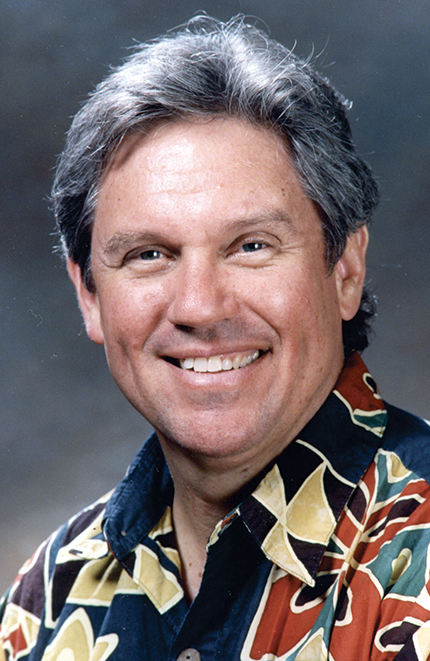Jerry Earl Nelson
DOI: 10.1063/PT.3.3854
Jerry Earl Nelson, the father of the segmented-mirror telescope and a towering figure in the history of telescope building, passed away on 10 June 2017 at his home in Santa Cruz, California.

Jerry Earl Nelson
UNIVERSITY OF CALIFORNIA, SANTA CRUZ

Jerry was born on 15 January 1944 in northern Los Angeles County to a father who was a machinist and a mother who ran a children’s center. He was introduced to astronomical research as a high school student in 1960 at the renowned Summer Science Program in Ojai (then in its second year) and to telescope building as an undergraduate physics major at Caltech when he assisted Gerry Neugebauer with the construction of a 1.5-meter IR telescope. Jerry so impressed his Caltech lab instructor and future colleague Eric Becklin with his experimental skill and thoroughness of approach that Becklin was still marveling about it 50 years later.
After graduating from Caltech in 1965, Jerry went on to graduate school at the University of California, Berkeley, where he shifted his interest to experimental particle physics. He received his PhD in 1972 under the direction of Burton Moyer. Staying on as a postdoctoral fellow at Lawrence Berkeley National Laboratory, Jerry returned to astrophysics. In particular, he applied his expertise in particle-physics electronics to a series of ingenious timing experiments at Lick Observatory that involved the Crab and other optical pulsars.
In 1977, University of California astronomers formed a committee to investigate what telescope to build as a successor to the Lick 3-meter. Jerry, who had caught the attention of some committee members with his optical pulsar work, was appointed to provide an outsider’s perspective. Astronomy would never be the same.
Jerry had an abiding love of first principles and a remarkable ability to see both their furthest reaching implications and a path to getting there; his mantra was, “It’s just freshman physics!” Preventing a mirror from distorting under gravity requires that its thickness increase as the square of the diameter, a fact that led Jerry directly to the concept of segmented mirrors. However, the idea of building a 10-meter-diameter mirror out of 36 segments raised some formidable problems.
Working with Terry Mast, who would be his close collaborator for 40-plus years, Jerry proceeded to solve those problems. In particular, his development, with Jacob Lubliner, of stressed mirror polishing solved the problem of how to fabricate large nonaxisymmetric optical segments, and his and Mast’s development of active electromechanical control systems allowed large numbers of such segments to remain locked together and function as a single, continuous optical surface. The first Keck telescope was such a success when it went into scientific operation in 1993 that by 1996 there was a second, virtually identical Keck. Within a few more years, Jerry was at work, again with Mast, on designing what is now the Thirty Meter Telescope (TMT), which is scheduled to begin construction later this year.
Jerry recognized that the enormous collecting area of the Keck telescopes made each photon more precious, not less. He worked tirelessly to help design and develop state-of-the-art instruments and to improve the telescopes’ performance. Every morning he reviewed the Keck night logs. He was a fixture as an outspoken member of the Keck Science Steering Committee.
Not only a truly great physicist, Jerry was a remarkable electrical engineer and a world-class mechanical engineer as well. He received both the 2010 Kavli Prize in Astrophysics and the 2012 Benjamin Franklin Medal for electrical engineering. His personality was as impressive as his professional accomplishments. The courage he manifested in the face of criticism and personal adversity was remarkable and inspiring. Although he had a physically debilitating stroke in late 2011, Jerry still went to work every day, including holidays, and was making essential contributions to both Keck and the TMT up until his final days. His optimism was relentless—he was undeterred by people constantly telling him he was trying to do the impossible—and his intellectual curiosity was legendary. He was a mentor of uncommon patience and generosity, and it is doubtful whether anyone, with the possible exception of his colleague Mast, got more joy out of his work.
Jerry’s vision, expertise, technical knowledge, and leadership made the twin Keck telescopes the first of the 8- to 10-meter telescopes to go into operation. The two Kecks, together with Jerry’s efforts as the founding director of the Center for Adaptive Optics at Santa Cruz, helped to usher in an unprecedented era of astronomical discovery that covered such diverse phenomena as exoplanets, the formation and evolution of galaxies, the acceleration of the expansion of the universe, and the black hole at the galactic center. Jerry had a profound influence on the careers of a hundred astronomers and telescope engineers. His continuing influence can be seen in the segmented-mirror design of ongoing telescope megaprojects, including the James Webb Space Telescope, the European Southern Observatory’s Extremely Large Telescope, and the TMT.
More about the Authors
Gary Chanan. University of California, Irvine.
